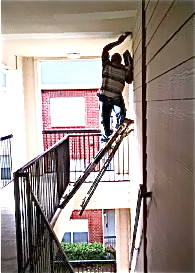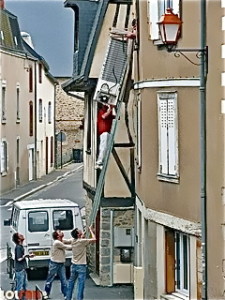Ladders – handy but dangerous:
- Some years ago now, a neighbour of ours had a ladder collapse under him while he was maintaining the gutters on his property.. He broke his feet, and spent many weeks in rehab.
- We have a client who is very involved in the public health sector. He reminded me recently of the stats relating to DIY injuries and disablements (is that a word?), particularly around ladders.

Since we recently posted some property maintenance comments, I thought it might be good to also remind you of some of the DIY injury stats…
The Australian National Coroners Information System (Coroners information system?) indicates:
- most people who died after falling from ladders were over 50 years old
- 32 per cent of deaths were in the 70-79 year age group
- 96 per cent of fatalities were male
- over 85 per cent of deaths occur in non-occupational activities
- 34 per cent of these deaths occur during home maintenance activities.
Most men injured or killed after falling from a ladder were at or nearing retirement age and were doing maintenance around the home.
Ladder injuries
A 2001 retrospective study undertaken on patients at the Austin and Repatriation Medical Centre in Victoria with ladder-related injuries found 43% of ladder accidents were caused by ladder instability.
were also identified as potential risk factors.
The study said users can avoid the risk of falling from a ladder by:
- securing the ladder, through either tying the ends or having another person brace it;
- Avoiding dangerous behaviour, such as
- Over-reaching;
- Carrying excessive loads or
- Deliberately moving the ladder during ascent.
- Pitching the ladder at an angle of 70-75 degrees relative to the (level) ground, as recommended by the Occupational Health & Safety guidelines for portable straight ladders
A study undertaken by specialists from the Emergency and Trauma Units at the

Royal Adelaide Hospital suggests an increase in recent years in injuries and deaths resulting from ladder falls.
The study suggested the increase may be related to:
- The increase in home DIY television programs which make home renovations look easy
- Expense and delays in getting qualified tradespersons to perform work make DIY renovations attractive
- An increase in the number of bush fire warnings that may induce people to take bushfire prevention measures themselves, such as trimming trees and cleaning gutters.
DIY safety tips
Before starting a DIY job, be sure to have appropriate safety gear. Getting injured for lack of say, gloves or safety glasses, could result in a hospital stay, and perhaps long recovery period away from work or your business. Much more costly than the few dollars for the equipment…
Use, handle and store materials and tools properly.
Monash University’s Injury Research Institute says that “every year 15 Victorians are killed and at least 2000 are seriously injured” through DIY.
So, DIY can create risks that should be taken seriously. Think before you start, not only about potential injury, but also about possible loss of income, mobility and even some faculties. Maintaining your property is important, but your health takes priority.
Preparation pays!











